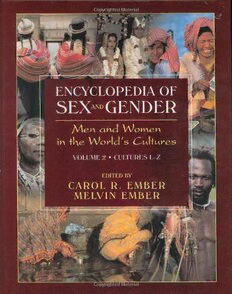
Encyclopedia of Sex and Gender. Men and Women in the World’s Cultures PDF
1071 Pages·2003·9.742 MB·English
Most books are stored in the elastic cloud where traffic is expensive. For this reason, we have a limit on daily download.
Preview Encyclopedia of Sex and Gender. Men and Women in the World’s Cultures
Description:
In many animal species, one can hardly tell the difference between females and males. Their size, coloring, and behavior may be so similar that even experts cannot readily tell the difference until they are ready to reproduce. In contrast, human females and males differ not only in secondary sexual characteristics, but they also generally exhibit differences in height, weight, and ratio of muscle to fat. Given the reproductive differences, as well as differences in appearance between males and females, it is hardly surprising that most, if not all societies conceive of females and males as important social categories. These reproductive and biological facts by themselves cannot explain the enormous variability in the way societies treat persons of the different biological sexes. The most sexually egalitarian societies may hardly treat males and females differently. But there are no societies that clearly give more overall advantages to females than to males, and those that advantage males vary considerably from mild to extreme inequality. The central aim of this encyclopedia is to give the reader a comparative perspective on issues involving conceptions of gender, gender differences, gender roles, relationships between the genders, and sexuality. This is done within the two main sections within the encyclopedia: Topics and Cultures. The topical overviews are divided into four sections: cultural conceptions of gender; observed differences between males and females in behavior and personality; institutionalized aspects of gender; sexuality and male-female interaction. The Cultures sections contains 82 specific cultural articles written by anthropologists or other social scientists who have lived with the people they write about and are able to give a vivid portrait of life in that society, which provide a "portrait" of how boys and girls grow up and become men and women in that society. Cultures from the widest possible spectrums-from egalitarian to stratified, from foragers to intensive agriculturalists, from those with kin groups structured around males to those structured around females, from those where the status of women and men is relatively equal to those where status is mostly unequal. We also have cultures from every major geographical region. The combination of topical overviews and varying cultural portraits is what makes this encyclopedia unique. This major reference work is an essential part of any institution's library and belongs in the library of every cultural and social anthropologist.
See more
The list of books you might like
Most books are stored in the elastic cloud where traffic is expensive. For this reason, we have a limit on daily download.
